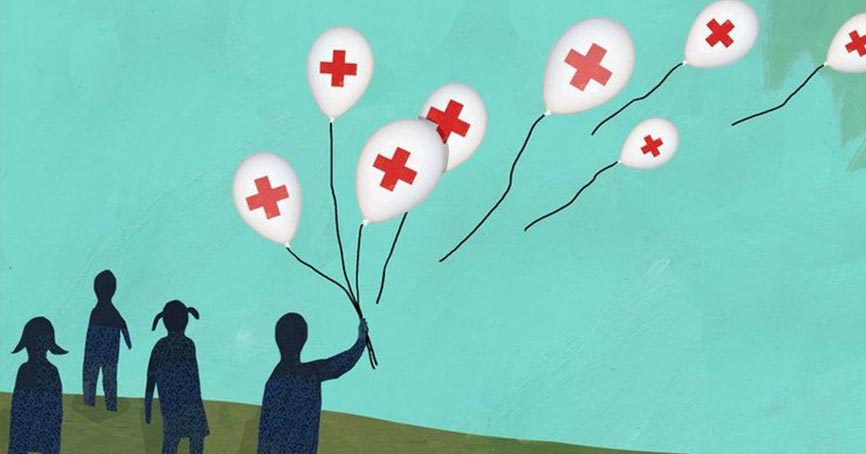A cyst is a fluid-filled pocket anywhere in the body. Ovarian cysts are located in the ovary of a woman and usually form during ovulation. Ovarian cysts are common in women who have not attained menopause yet. Most of the time, ovarian cyst symptoms do not exist. They are painless and harmless and women don't even come to know about them. Usually, cysts go away without treatment and occur during pregnancy.
A cyst is harmful and painful when either it doesn't go away or keeps getting bigger. In certain cases, it may lead to cancer which has more chances when one gets older.
Ovarian Cyst Types
Ovarian cysts mostly form during the menstrual cycle. One of the most common types of ovarian cysts can be identified as functional cysts and are usually benign.
The two major types of ovarian cysts are-
Follicle Cyst
During the menstrual cycle, the egg grows in a sac known as a follicle which is located in the ovaries. Mostly, the follicle breaks open releasing an egg after it matures. However, if this doesn't happen, the fluid inside the follicle forms a cyst in the ovary.
Corpus Luteum Cysts
Once the egg is released, follicle sacs typically dissolve. However, in case opening of the follicle seals and the sac does not dissolve, unnecessary fluid may develop inside the sac. This accumulation of fluid results in a corpus luteum cyst.
Other types of Ovarian cysts are-
- Dermoid Cysts- Usually, it comes from cells present during birth and has no symptoms. It is a sac-like growth on the ovaries which contain fat, tissue and hair.
- Endometriomas- Endometriosis is caused due to endometriosis which results in cysts. The tissues that normally grow inside the uterus start developing outside the uterus and attach to the ovaries.
- Cystadenomas- Cystadenomas is a noncancerous growth that develops on the outer surface of the ovaries. Filled with a watery fluid, it may sometimes grow extremely large.
A very common condition that women have been facing is the PCOS or Polycystic Ovary Syndrome. In this condition, the ovaries contain many small cysts which may enlarge them. If left untreated, this condition can result in infertility.
Malignant cysts are a rare find and are more common in older women.
Ovarian Cyst Causes
Ovarian Cancer may be caused due to a number of factors. Some of the reasons that may increase the risk of ovarian cancer are-
- Hormonal Problems- Hormonal problems may be caused due to a variety of reasons like taking the fertility drug clomiphene which is used for ovulation.
- Pregnancy- In some cases, the cyst formed during ovulation stays there throughout the course of pregnancy.
- Pelvic Infection- In case the infection in the pelvic area spreads to the ovaries it may result in cysts.
- Ovarian Cyst- A history of ovarian cysts may result in more cysts over the course of time.
- Endometriosis- In this condition, the uterine endometrial cells grow outside the uterus. Some tissues may attach to the ovary and form a cyst-like growth.
Ovarian Cyst Symptoms
Ovulation is a process that happens when the ovary releases an egg every month. Many women who have ovarian cysts do not have symptoms.
Most ovarian cysts do not come to notice and can disappear without coming to notice or receiving treatment. However, when it does cause symptoms, the most common one has to be a pain in the abdomen or pelvis area. The pain could be a result of-
1. Rapid Growth or stretching
2. Bleeding into the cyst
3. Ruptured Cust
4. Torsion- Twisting of the cyst around its blood supply
If the cyst expands way too much in terms of size, other symptoms may arise due to pressure or distortion of adjacent anatomical structures. Some of the other symptoms are-
- Lower Back Pain
- Indigestion
- Abdominal Fullness- Expansion of abdomen/ Bloating
- Feeling full after eating small amounts of food
- Urinary Urgency
- Pain during sexual intercourse
- Urge to Defecate
- Problems during emptying the bladder
- Difficulty during bowel movements
Also, if one has signs of shock like cold and clammy skin, rapid breathing and lightheadedness or weakness, it is best to see the doctor.
Ovarian Cyst Complications
Some women may develop different types of cysts that a doctor identifies during a pelvic exam. Moreover, cystic ovarian masses that develop after menopause might be malignant. This is the reason one must have pelvic exams regularly.
Some of the infrequent complications associated with ovarian cysts are-
- Rupture- A ruptured cyst may result in internal bleeding and severe pain. Vigorous activities affecting the pelvis, like vaginal intercourse, also increase the risk. If the cyst is large, the risk of rupture increases.
- Ovarian Torsion- Enlarged cysts may cause movement in the ovaries increases the risk of painful twisting of the ovary. Some of the symptoms of ovarian torsion are an abrupt onset of severe pelvic pain, vomiting, and nausea. This condition may also decrease/stop the blood flow to the ovaries.
Bibliography
- https://www.medicinenet.com/ovarian_cysts/article.htm#what_about_ovarian_cysts_during_pregnancy
- https://www.womenshealth.gov/a-z-topics/ovarian-cysts
- https://www.mayoclinic.org/diseases-conditions/ovarian-cysts/symptoms-causes/syc-20353405
- https://www.healthline.com/health/ovarian-cysts#types
- https://www.webmd.com/women/guide/ovarian-cysts#1
- https://en.wikipedia.org/wiki/Ovarian_cyst
- https://www.onhealth.com/content/1/ovarian_cysts

 Jun 03, 2019
Jun 03, 2019
 May 30, 2018
May 30, 2018 May 10, 2018
May 10, 2018 May 17, 2018
May 17, 2018